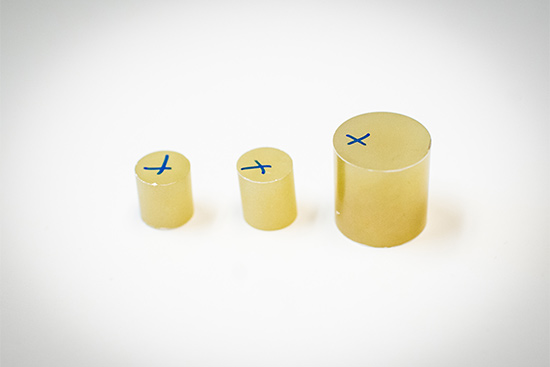Alex Sushkov is trying to catch a ghost. Or perhaps, the shadow of a ghost.
Sushkov is searching for axions—particles first postulated in 1977 but never detected. If they exist, say theorists, axions will be smaller than neutrinos, which are so tiny that they have nearly no mass. The quest to find them seems quixotic, but, if Sushkov succeeds, he may answer a cosmic question that has baffled scientists for decades: what is dark matter?
“Dark matter is a huge mystery—we know it’s there, but we don’t know much about it,” says Sushkov, a College of Arts & Sciences assistant professor of physics, a 2016 Sloan Research Fellow, whose work is also funded by the Heising-Simons Foundation and the Simons Foundation.
The idea of dark matter was born in the 1970s, when scientists—in particular, the American astronomer Vera Rubin—studied the movement of stars around galactic centers and found something peculiar: the stars were moving much faster than expected, given their mass. Something was propelling them, or pulling them, but what? “It was as if there is something there that no telescope could see,” says Sushkov. “And that thing is dark matter.”
Scientists call dark matter “dark” because it doesn’t emit electromagnetic radiation, including light, so they can’t see it; they can only infer its existence by its gravitational pull. And while there is wide scientific consensus that dark matter exists, and that it’s everywhere, says Sushkov, there are differing theories on what it actually is. The three leading contenders: axions, black holes, and weakly interacting massive particles—better known as WIMPs. For years, physicists have been betting on WIMPs, building ever-more-massive experiments to find them. The latest, the LUX-ZEPLIN (LZ) experiment being built in an underground mine in South Dakota, will contain seven tons of liquid xenon and will be able to detect as little as one WIMP a year. “If they don’t find anything, the WIMP is very likely done for,” says Steven Ahlen, a CAS professor of physics. “If they don’t find it in the next couple of years, there’s no hope. That makes it a very exciting time in physics.”

Sushkov’s detector contains tiny cylinders, each holding a few grams of lead titanate. The lead atoms will, hopefully, respond to a wave of axions sweeping by, offering clues to the character of dark matter.
Sushkov is bypassing the WIMPs and betting on axions, and he’s building an experiment to do what no one has done before: detect their quiver through the universe.
Axions are so small, says Sushkov, that they act more like a fluid or a wave, rather than a particle. And so, like a radio operator listening for distant broadcasts, he needs tiny antennas to perceive the axions’ presence. He’s building a detector, about the size of a refrigerator, in a basement lab of BU’s Metcalf Science Center. The detector contains three tiny cylinders, only 5 mm long, each holding a few grams of a yellow powder called lead titanate. Those are the antennae. Lead titanate is “not a fancy-schmancy material,” says Sushkov, but it has the right character to respond to axions: it’s ferroelectric, meaning its atoms can be spun around by an external electric field. And although the spin of each lead atom is oriented randomly, the right type of signal can make all of them act in unison.
Theory predicts that a wave of axions sweeping through the detector would make the spins gyrate or “precess” in harmony, like a troupe of well-trained hula dancers. Magnetic field detectors in the device, which scientists can tune with an external magnetic field, will sense the gyrations and signal the presence of axions. Sushkov calls his detector the Cosmic Axion Spin Precession Experiment, or CASPEr.
“It’s kind of like looking for intelligent life in other parts of the universe—you have to look at a lot of different frequencies. If it’s not on one channel, it might be on another,” says Ahlen. “It’s a long-shot experiment, but if it succeeds, the results would be incredible.”
One of the challenges of the experiment is to isolate the lead titanate so it will detect axions only, not trucks rumbling past or grad students yakking on their cell phones. To block all unwanted signals and make the detector more sensitive, the lead titanate samples sit within liquid helium at a frigid 4 degrees Kelvin—that’s -452 degrees Fahrenheit—in a container isolated from vibrations and from electromagnetic interference.
Several other groups of scientists around the world are searching for axions, but Sushkov and his team are the first to use this method. They are still finishing and troubleshooting the detector, which should start gathering data in spring 2017.
“Day to day, as with any job, you’re dealing with problems, like something is broken, or there’s some power-line interference,” says Sushkov. “But every now and then it’s exciting to sit back and think about the cosmic implications of the work. It’s inspiring to listen to the universe.”















































Related Stories
Two BU Scientists Win Sloan Fellowships
Astronomer Catherine Espaillat, physicist Alex Sushkov
BU Neutrino Researchers Share Global Physics Honor
Breakthrough Prize recognizes work on fundamental particle of the universe
The Atom Smasher
CAS prof searches for “new” physics
Post Your Comment